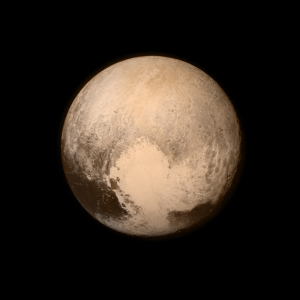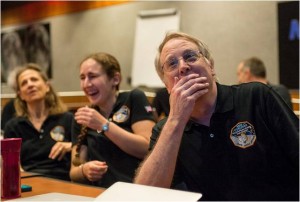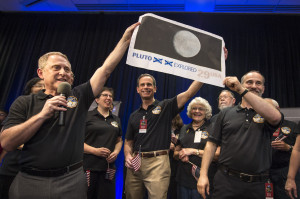
Pluto nearly fills the frame in this image from the Long Range Reconnaissance Imager (LORRI) aboard NASA’s New Horizons spacecraft, taken on July 13, 2015 when the spacecraft was 476,000 miles (768,000 kilometers) from the surface. This is the last and most detailed image sent to Earth before the spacecraft’s closest approach to Pluto on July 14. The color image has been combined with lower-resolution color information from the Ralph instrument that was acquired earlier on July 13. This view is dominated by the large, bright feature informally named the “heart,” which measures approximately 1,000 miles (1,600 kilometers) across. The heart borders darker equatorial terrains, and the mottled terrain to its east (right) are complex. However, even at this resolution, much of the heart’s interior appears remarkably featureless — possibly a sign of ongoing geologic processes.
Credit: NASA/APL/SwRI
The New Horizons spacecraft has made a historic flyby of Pluto, with the probe making its closest pass at 7:49 a.m. ET on July 14.
The piano-sized robotic spacecraft zoomed by distant Pluto at a distance of 7,750 miles away, zipping by at nearly 31,000 miles per hour.

Members of the New Horizons science team react to seeing the spacecraft’s last and sharpest image of Pluto before closest approach later in the day, Tuesday, July 14, 2015 at the Johns Hopkins University Applied Physics Laboratory (APL) in Laurel, Maryland.
Credit: (NASA/Bill Ingalls)
The flyby for New Horizons capped a mission that started at Cape Canaveral, Florida, on Jan. 19, 2006. Three billion miles later, New Horizons became the first mission from Earth to investigate Pluto and its five moons.

This July 13, 2015, image of Pluto and Charon is presented in false colors to make differences in surface material and features easy to see. It was obtained by the Ralph instrument on NASA’s New Horizons spacecraft, using three filters to obtain color information, which is exaggerated in the image.
These are not the actual colors of Pluto and Charon, and the apparent distance between the two bodies has been reduced for this side-by-side view.
The image reveals that the bright heart-shaped region of Pluto includes areas that differ in color characteristics. The western lobe, shaped like an ice-cream cone, appears peach color in this image. A mottled area on the right (east) appears bluish. Even within Pluto’s northern polar cap, in the upper part of the image, various shades of yellow-orange indicate subtle compositional differences.
The surface of Charon is viewed using the same exaggerated color. The red on the dark northern polar cap of Charon is attributed to hydrocarbon materials including a class of chemical compounds called tholins. The mottled colors at lower latitudes point to the diversity of terrains on Charon.
This image was captured at 3:38 a.m. EDT on July 13, one day before New Horizon’s closest approach to Pluto.
Credit: (NASA/APL/SwRI)





